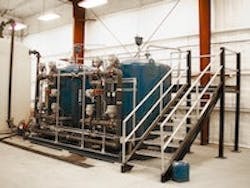Nevada Community Rushes to Meet EPA Arsenic Level Standard
With the U.S. Environmental Protection Agency (EPA) now requiring arsenic levels of 10 ppb for drinking water, reducing high levels of arsenic in one of its community’s water supply has been a challenge for Eureka County, Nev.
Find out how a community that once searched for silver hunts down a way to remove high levels of arsenic from its drinking water.
Project Background
For years, Eureka County has been finding something else in the drinking water supply of one of its communities, Crescent Valley—something that is quite common to water supplies in the western United States: arsenic. With levels of 13.25 and 13.5 ppb in the system’s two wells, the Crescent Valley Water System needed to meet the new EPA standard for drinking water of 10 ppb. The county contracted with Day Eng. of Fallon and Ely, Nev., to determine the best way to reduce the arsenic.
De Nora Water Technologies’ SORB 33 arsenic removal system, utilizing Bayoxide E33 was selected as the treatment method for the removal of the arsenic following a successful pilot test demonstrating the systems ability to remove arsenic successfully. The SORB 33 arsenic removal system is a fixed-bed adsorption system using Bayoxide media. The system employs a simple “pump and treat” process that flows pressurized well or spring water through a fixed-bed pressure vessel containing the iron-oxide media.
Arsenic has a high affinity for iron-oxide-based minerals and can adsorb quickly to the surface of the media. This makes granular iron oxide media, such as Bayoxide, excellent for arsenic removal. Both arsenite (arsenic III) and arsenate (arsenic V) oxyanions are removed from water via a combination of oxidation, adsorption, occlusion (adhesion) or solid-solution formation by reaction with ferric oxide ions. Other contaminants common to groundwater also have a high affinity for iron-based minerals. This creates competition among ions, resulting in less arsenic being adsorbed per volume of treated water. Bayoxide E33 is specifically designed to adsorb arsenic while reducing competition with other ions, thus improving the arsenic-adsorbing potential of the media.
Pilot Testing Arsenic Treatment Solutions
Day Eng. coordinated a 30-day pilot study with three companies, with technologies including coagulation/filtration and adsorption. According to Martin Ugalde, the company’s project manager, coagulation/filtration had been shown to pose operational challenges in other demonstrations.
“There are more chemicals required with coagulation/filtration, and the sludge byproduct from backwash must be managed,” Ugalde said. “The chemical, typically including ferric chloride, is also highly corrosive and can damage chemical feed pumps in as little as a year.”
Upon evaluating the three bids, Day Eng. recommended the adsorptive technology provided by De Nora Water Technologies’ SORB 33 arsenic removal system, utilizing Bayoxide E33. According to Ugalde, there were two major determining factors in selecting the adsorptive process: ease of operation and simplicity in modifying operating set points, and operations and maintenance costs.
Arsenic Treatment System Operation
To meet the drinking water needs of approximately 265 residential and commercial customers in Crescent Valley, Day Eng.’s plan called for the construction of a 350-gal-per-minute (gpm) arsenic treatment plant. New, dedicated water mains were laid from each of the two groundwater wells directly to the new water treatment plant because the presence of arsenic has rendered the wells’ water non-potable. The plan also called for the drilling of a new 12-in.-diameter by 560-ft-deep well to replace one of the two existing wells, the casing of which was found to have significant corrosion that could potentially allow external contaminants into the water supply. The new well was drilled within 100 ft of the damaged well in order to match its water quality. It was constructed of stainless steel well casing and screen, and a 40-hp Grundfos stainless steel submersible well pump set at 460 ft with a stainless steel drop pipe. Water from the two source wells is pre-chlorinated with a 12.5% sodium hypochlorite solution before it flows into the SORB 33 system. Two 8-ft-diameter SORB adsorption vessels, each containing 169 cu ft of Bayoxide E33 media and able to treat 175 gpm, run in parallel. At this time, none of the water is bypassed; the entire flow is treated, achieving an arsenic level of 1 ppb.
According to the water system operator plant’s operator, Bruce Harland, “Everything is working excellently. I haven’t had to backwash the system for a month because the differential pressures haven’t approached 10 psi. We are very happy with the way the plant is running.”
